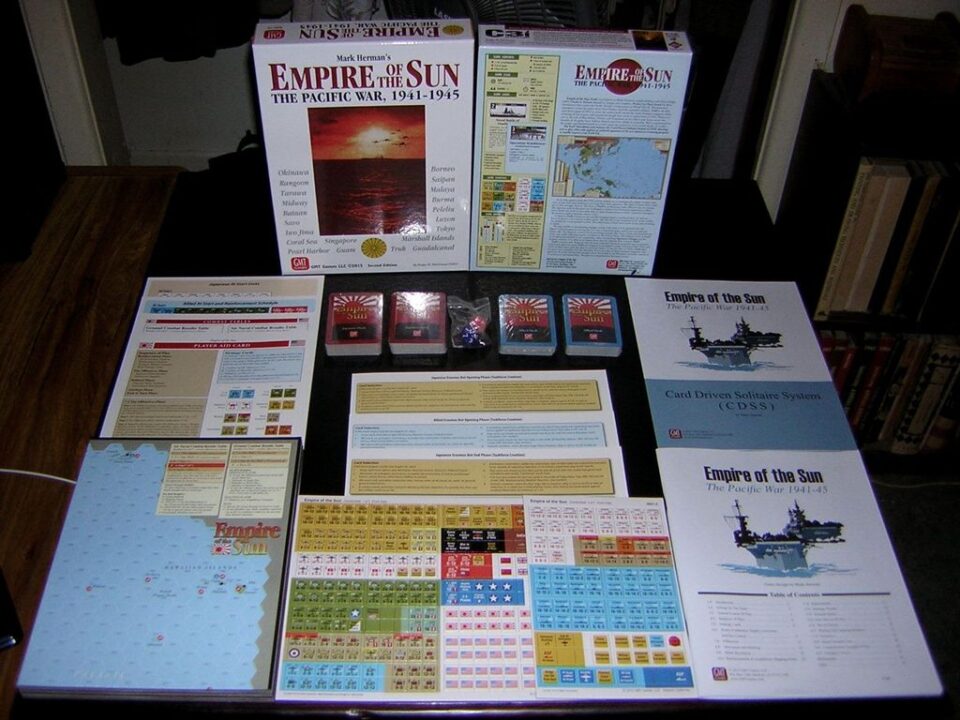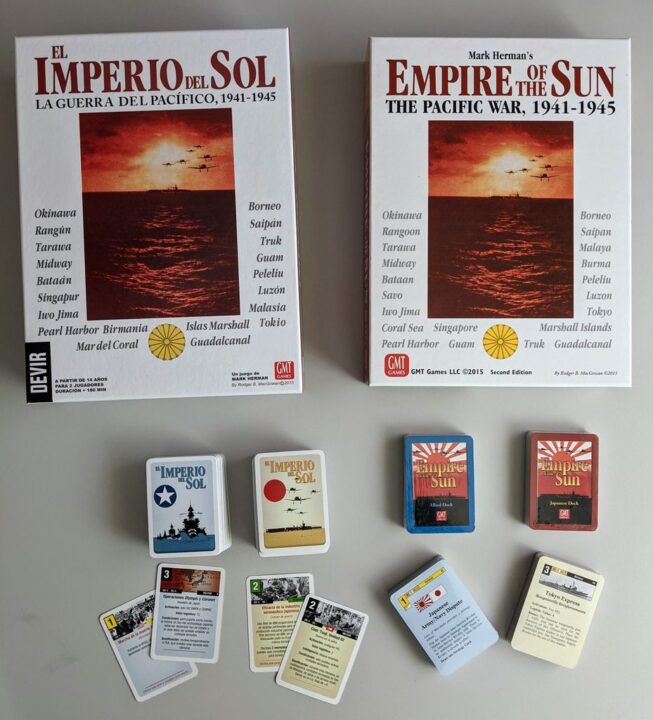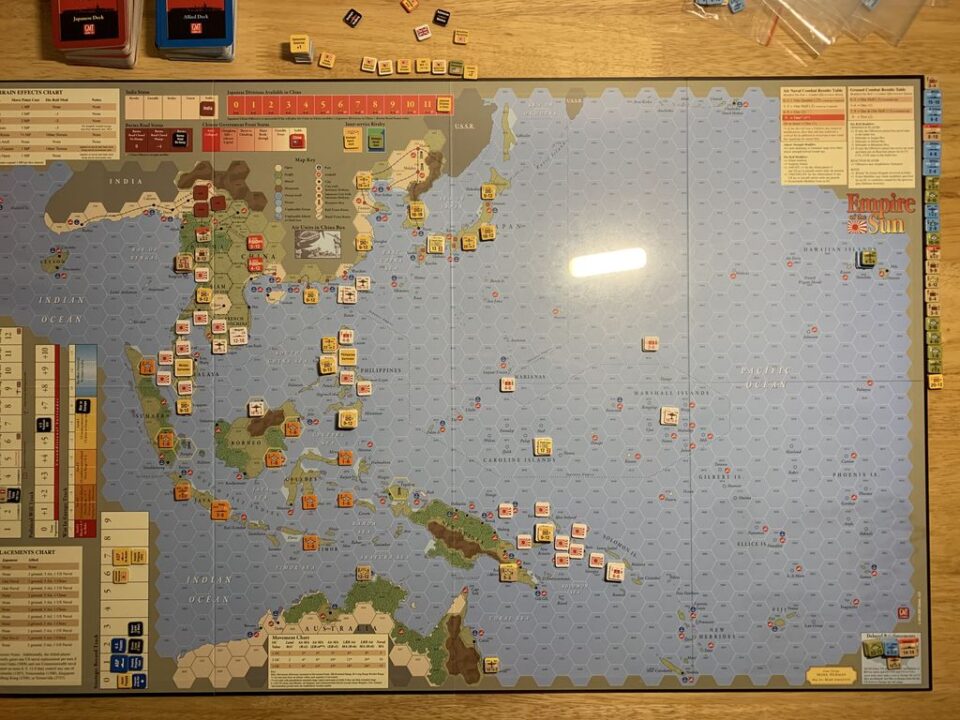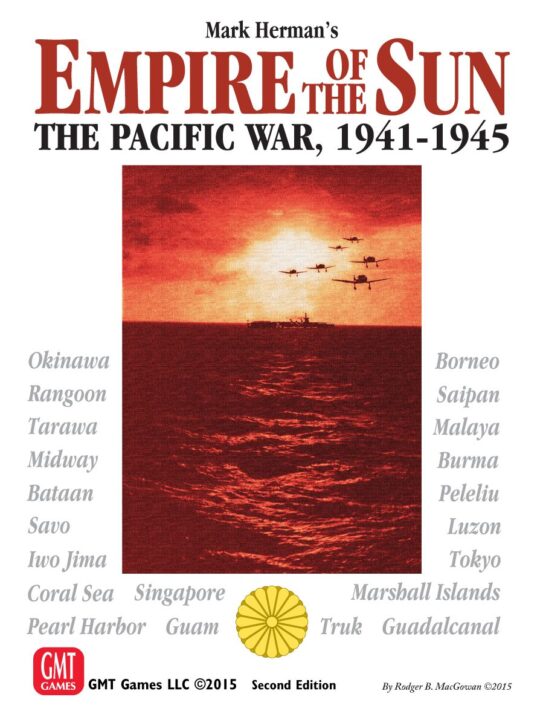Alright, let’s talk about Empire of the Sun! As someone who loves a good strategy game—so much I sometimes dream about cardboard battle lines—this review is for those who want to know what’s behind all that map and counter madness. I grabbed some friends, snacks, and tried not to flip the table in frustration. From the card-driven gameplay to the tough learning curve, I’m here to share what really works, what irritated us, and if you’ll need to sell your soul or just a few evenings to master this beast. Grab your dice (just kidding, you won’t need many), and let’s see if Empire of the Sun is the epic you’ve been searching for, or if you’re better off watching documentaries about the Pacific!
How It Plays
Setting up
You pick sides: U.S. or Japan. Lay out the big ol’ Pacific map, shuffle the card decks, and place unit counters where the rules tell you. Get your supply markers and air units ready. Grab snacks, because this takes a bit!
Gameplay
Take turns playing cards. Each card lets you move armies, launch attacks, or mess with your opponent’s plans. Fighting means placing units and rolling dice (don’t worry, skill matters more than luck). You plan strategies, manage your supply lines, and try not to make embarrassing blunders like I did by moving my fleet the wrong way. Every game year brings new twists and tough choices.
Winning the game
The game ends after a set number of turns or if someone pulls off a major victory early (hint: take Manila or deal a crushing blow!). Count up victory points based on your objectives. My friend once beat me by a single point, which I may never live down. Whoever has the most points wins—cue the triumphant (or tragic) celebration.
Want to know more? Read our extensive strategy guide for Empire of the Sun: The Pacific War 1941-1945.
Game Mechanics and Strategic Depth in Empire of the Sun
Empire of the Sun is not the kind of game you break out during a sleepy Tuesday night. My mate Tom looked at the map and said, “Am I supposed to bring my own magnifying glass?” Because yes, the detail is unreal. But that’s why fans love it.
Let me tell you, the core mechanic here is card-driven and each card means tough choices. You want to move your navy? That’s one card. Want to beef up your land defenses? That’s another card. But hang on, you only get a handful each turn. So, most turns, I found myself choosing between stopping a wild offensive or trying to set up my own big moves. It made my brain hurt—in the best way.
This game gives you deep layers, like a lasagna of strategy. There’s a constant push and pull between Japan and the Allies, and every card play could mean the difference between a win and a “well, there goes the Pacific.” I tried to be clever and hold back powerful cards for later, which made me feel like a genius—until Tom did something unpredictable with air units and the whole table gasped (twice).
Empire of the Sun also makes you think far, far ahead. You can’t just hope for the best and wing it. If you don’t plan several moves in advance, you’ll end up with your aircraft carriers parked somewhere strange, and Tom will remind you about it for months to come.
Overall, this isn’t a game for folks who want simple rules or quick turns. But if you love planning, tricking your friends, and the kind of strategy that sticks in your brain, this one’s for you. Next up, I’m going to talk about whether luck or skill is your best friend (or worst enemy) in this war of cardboard empires.

Empire of the Sun: Balance Between Luck and Skill
Every board game fan asks the same thing: is this a game of brains, or just blind luck? When I sat down with Empire of the Sun, I expected a classic luck-fest, because the Pacific War is wild and unpredictable. But let me tell you, this one is heavy on the skill! There are cards, sure, but you still have to plan, bluff, and sometimes cry as your buddy launches a surprise offensive that ruins your week.
The most luck you’ll find here comes from the event cards. You never know what card will come up next, and sometimes the gods of cardboard decide to give you nothing but weather or political grumbles. But, here’s the thing: the unpredictability doesn’t take over the game. Nine times out of ten, good players still win. If you use your cards well, manage your troops, and pay attention to supply lines, you will feel like a tiny Eisenhower with a slightly sore back from leaning over the map too long.
If you lose in Empire of the Sun, it’s probbly because you made a mistake, not because your opponent drew “Lucky Strike” and you didn’t. That’s a huge plus in my book. I want to win (or lose) because of my choices, not my dice hands. And here, skill truly rules the day, so strategy lovers rejoice!
Speaking of maps, get ready: next up, I’ll spill the beans on those chunky components and the epic map design—no reading glasses required!

Component Quality and Map Design in Empire of the Sun
Let’s talk about the stuff you actually touch! Empire of the Sun comes in a box that looks like it means business. The board is huge—no joke, it nearly ate my whole kitchen table. I highly recommend playing somewhere with more space than my apartment, unless you enjoy balancing game tokens on top of your cat. It’s a sturdy board, though. The print is sharp, the Pacific theater pops, and even my friend Steve (who once mistook a submarine for Australia) had an easy time following the map.
The counters are thick and punch out easier than my patience after three hours of play. There are hundreds of these little bits, each showing divisions, fleets, air units—basically a tiny cardboard army for every side. I did find myself squinting at the numbers sometimes, but that’s more because my eyesight is as old as most of the battles depicted. Still, I wish the color contrast was a little punchier. On the plus side, the cards have that nice, shufflable feel and survived my group’s patented “shuffle of doom,” where we always manage to send something flying under the fridge.
As for the map design, it’s not only detailed but smart. Territories and sea zones are sized and spaced to help you plot your next sneaky move. Every place you need to see is right there—no magnifying glass needed. The only downside? Your first time, the map will look like a puzzle that’s missing the box art. But after a round or two, the layout clicks.
Now, if you’re curious about how many times my friends have demanded a rematch and who learned the rules the hard way, stick around for the next section: Replayability and learning curve!

Replayability and Learning Curve: Will Empire of the Sun Keep You Coming Back?
Let’s talk replayability, because nobody wants to spend hours learning a game only to play it once. And with Empire of the Sun, you won’t have that problem. This game is a beast—in a good way. I’ve played it six times now, and every match felt different. The card events mix things up, of course, but what really grabbed me is how each player’s plans change when the other side does something sneaky, like landing way behind my front lines. I still have nightmares about that.
The map gives you room to try wild strategies, so every game feels like a fresh puzzle. One day, I’m defending Burma like a pro, the next I’m stretched so thin I might as well be paper. There’s always a reason to come back and say, “Next time I’ll do better!”
But let me warn you: the learning curve is steep. Empire of the Sun does not handhold. My first two games felt like drinking from a fire hose. The rulebook is big enough to stun a yak. I spent the first afternoon mixing up zones of control and getting trounced by my overly smug friend Dave. But stick with it, because after a few games, the rules click and things start to make sense. Perseverance pays off, and suddenly you’re the one making Dave sweat.
If you love figuring things out and playing a game that rewards you for learning, I strongly recommend Empire of the Sun. Just don’t expect to master it by dinner time!
Conclusion
Well, that wraps up my review of Empire of the Sun. If you like big brain strategy and don’t mind a tough learning curve, this game’s a gem. The map looks sharp, the pieces can take a beating, and there’s loads of replay value. Just be ready to read the rulebook twice (or seven times, if you’re like me). Luck barely whispers here, so it rewards careful planning. It’s not for folks who want quick turns or dice rolling drama, but if you crave a deep back-and-forth, Empire of the Sun is worth your table space. Happy (paper) warring!


